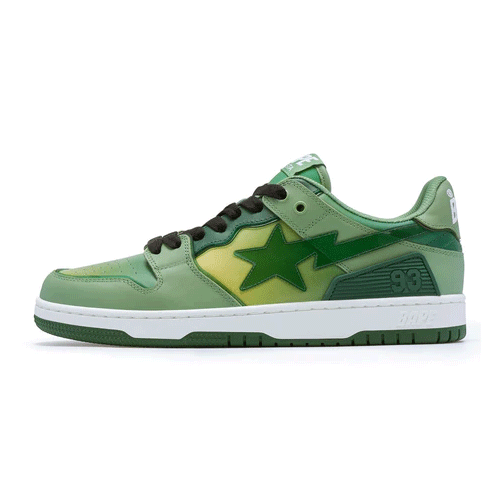In the vibrant world of streetwear and sneaker culture, few silhouettes have achieved the legendary status of the Bapesta. Bold, controversial, and undeniably influential, the Bapesta represents more than just footwear—it’s a statement, a symbol of rebellion, and a cornerstone of Japanese fashion. Born from the creative mind of Nigo and the powerhouse brand A Bathing Ape (BAPE), the Bapesta has carved out its own lane in a market dominated by Western giants like Nike and Adidas.
This article takes you deep into the history, evolution, cultural significance, and future of the Bapesta. Whether you’re a seasoned sneakerhead or a newcomer to streetwear, you’re about to see why the Bapesta continues to stand tall decades after its debut.
The Birth of Bapesta: A Bold Statement from BAPE
To understand the impact of the Bapesta, you need to first understand BAPE, the Tokyo-based streetwear brand founded by Nigo in 1993. Inspired by hip-hop, American pop culture, and military aesthetics, Nigo launched BAPE as a countercultural movement, and in 2000, he introduced the world to one of its most iconic creations—the Bapesta sneaker.
At first glance, the Bapesta looks remarkably familiar. Its silhouette is heavily inspired by the Nike Air Force 1, a choice that sparked both criticism and admiration. But while some dismissed it as a “copy,” others saw it for what it was: a reinterpretation with cultural significance, decked out in wild colors, patent leathers, and the signature star logo replacing the Nike Swoosh.
In Japan, where Western streetwear was admired but not always accessible, the Bapesta was a revolution. It offered a uniquely Japanese take on American sneaker culture, and for a generation raised on hip-hop and MTV, it was love at first sight.
Celebrity Co-Signs and Cultural Explosion
One of the biggest reasons the Bapesta exploded in popularity during the early 2000s was the endorsement of American hip-hop artists. Pharrell Williams, Kanye West, Jay-Z, and Lil Wayne were all seen rocking Bapestas, often customized in vibrant, never-before-seen colorways. Pharrell even collaborated with Nigo on the Billionaire Boys Club (BBC), further blurring the lines between music and fashion.
These endorsements weren’t just accidental. Nigo understood the power of celebrity and culture better than most. He strategically placed Bapestas on the feet of tastemakers, turning the sneaker into a global phenomenon. In the era before sneaker blogs and Instagram hype, word of mouth and magazine spreads did the heavy lifting. And Bapesta was everywhere.
The Design That Broke the Mold
What set the Bapesta apart wasn’t just its similarity to the Air Force 1—it was its execution. The sneaker embraced boldness without apology. Where Nike kept things relatively clean and uniform, BAPE went the opposite route: metallics, camo patterns, pastel pinks, glossy finishes, and characters from the BAPE universe like Baby Milo were all fair game.
This fearless approach made the Bapesta a collector’s dream. No two drops felt the same. Limited editions, regional exclusives, and pop culture-inspired designs kept fans guessing and camping outside stores. BAPE didn’t just sell sneakers; it created an experience, a community, and a sense of identity.
Controversy and Legal Pushback
Of course, the similarities between the Bapesta and Nike’s Air Force 1 weren’t overlooked by sneaker purists—or Nike itself. Over time, whispers turned into legal challenges. While the exact legal battles remain partially behind closed doors, BAPE eventually began tweaking the Bapesta’s silhouette in subtle ways to differentiate it further from Nike’s design.
This shift didn’t hurt the brand; in fact, it helped. As the Bapesta matured, so did its identity. It moved from imitation to innovation, adapting to trends while retaining its core DNA. In the eyes of many, this evolution solidified its legitimacy as a cultural force.
The Resurgence: Bapesta in the Modern Sneaker Era
After a few quieter years in the late 2010s, the Bapesta has seen a powerful resurgence. Driven by Gen Z’s love for nostalgia, 2000s fashion, and the renewed popularity of Japanese streetwear, the sneaker has once again found itself at the center of attention.
Collaborations with artists like Kid Cudi, J. Cole, and Skepta, along with revamped versions featuring more modern silhouettes and materials, have put Bapesta back on the radar. Limited-edition drops, capsule collections, and new global BAPE stores have created fresh hype for a new generation.
What’s more, in an age dominated by Instagram and TikTok, the Bapesta’s visually loud design thrives. It’s a sneaker that demands attention—and that fits perfectly with today’s culture of personal branding and curated aesthetics.
Bapesta vs. the World: How It Stands Today
In a crowded sneaker market, the Bapesta remains unique. It doesn’t compete with Nike’s technological innovation, nor does it follow Adidas’ performance wear route. Instead, it stays true to what made it famous—style, attitude, and identity.
While resale prices vary, rare colorways and collaborations still command high value on platforms like StockX and GOAT. For collectors, owning a pair of OG Bapestas is like owning a piece of streetwear history. For younger fans, it’s a bridge to a golden era of hip-hop, fashion, and DIY culture.
More importantly, the Bapesta has inspired other brands to take similar risks. It proved that a sneaker didn’t need athletic credentials to make waves. It just needed vision, timing, and a fearless sense of creativity.
How to Style Bapestas in 2025
With their bold colors and distinctive look, Bapestas can be tricky to style—but that’s part of the fun. Today’s streetwear scene embraces individuality, and the Bapesta fits right in. Pair them with baggy cargos, oversized graphic tees, or even Japanese selvedge denim for a retro-meets-modern aesthetic.
Layering is key. Add a BAPE shark hoodie, a vintage varsity jacket, or a loose-fitting flannel to complete the look. If you’re going for a more minimal fit, let the sneakers be the standout piece against a neutral backdrop.
The key is confidence. The Bapesta isn’t subtle, and it isn’t supposed to be. It’s about making an entrance, owning your style, and paying homage to a rich cultural legacy.
The Legacy of Bapesta: More Than a Sneaker
When you lace up a pair of Bapestas, you’re not just wearing shoes—you’re stepping into a legacy. From Tokyo’s backstreets to the stages of global hip-hop, the Bapesta has walked a long road, and it continues to evolve with every step.
It represents a pivotal moment in fashion history when the East met the West, when underground culture went mainstream, and when imitation gave birth to innovation. In a world where trends come and go at lightning speed, the fact that the Bapesta still holds relevance is proof of its cultural power.
Final Thoughts
Whether you’re a collector, a fashion enthusiast, or simply someone who appreciates iconic design, the Bapesta is a sneaker worth knowing. Its journey from controversy to classic, from subcultural symbol to mainstream staple, is a testament to how fashion can tell stories, break boundaries, and bring people together.


